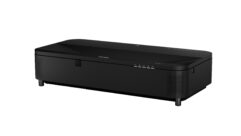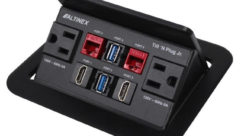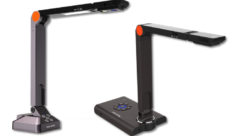
A New “Take” on Projector Mobility
Jun 8, 2006 8:00 AM
Mitsubishi’s PocketProjector, a 14oz., DLP-based personal projector, follows a nationwide trend to meet the consumers’ need for a smaller and lighter projector.
Road Warrior – now there’s a term we haven’t heard much lately.
Once upon a time, it seemed the entire projection industry was competing to serve the business man or woman who needed a projector that could be carried on the road, stuck in an overhead luggage rack, and set up quickly in a client’s conference room.
The Road Warrior needed a smaller and lighter projector, and the target kept moving: under 10 pounds, under eight pounds, under five pounds, etc.
Today’s newest projector rage is a device that could fit into your pocket, and instead of setting it up in a client’s conference room, the Road Warrior could take out the projector on an elevator for an impromptu presentation.
This week’s Infocomm International is showcasing an array of these new “pocket projectors,” which were announced throughout 2005 and started reaching the retail market late last year. Most of the industry’s big projection names have a product in the category, and growth prospects seem to be brightening.
(PocketProjector is a trademark of Mitsubishi Digital Electronics America, but the two-word, lower-case “pocket projector” is widely used as a generic term.)
Pacific Media Associates projects that unit sales for pocket projectors should be about 20,000 this year, but this number should surge to more than 1.5 million in 2010. Revenues over the same period should jump from about $15 million to more than $500 million.
Michael Abramson, PMA vice president, predicts pocket projectors will evolve from stand-alone products to integrated parts of such devices as PDAs and cell phones.
The consumer market is poised to snatch up a large part of this volume, of course, since pocket projectors will be so easy to take along on vacations for spontaneous slideshows and quick viewing of new digital photos. Corporate users are also lining up, in the hope of realizing a level of mobility and ubiquitous presentation capability that hasn’t been seen before.
The trade off, for the foreseeable future, will likely be brightness. Pocket projectors use an LED light source, although models in development may use lasers. The LED is coupled with a DLP imaging engine from Texas Instruments. The result is brightness of about 100 lumens–quite poor by the standards of widely available projectors that deliver 1,000 and more lumens from packages only a couple of pounds heavier than the “pocket” device.
Pocket projectors are also typically battery-powered and operate wirelessly, eliminating the need for power cords and cables. And the LED light source does provide an “instant-on” capability that conventional projectors lack.
So if a 30in. image projected on the wall of your own cubicle is all you need, or you want to be able to stage a presentation in moments, one of the new crop of pocket projectors might be just the thing.
Last year saw pocket projector introductions by Mitsubishi early in the year, and by other such manufacturers as Epson and Samsung in later months.
Mitsubishi’s device weighs in at 14oz. and can project a 40in. image with less than a yard of projection distance. Resolution is SVGA, 800×600 pixels.
In addition to brightness, another stumbling block for pocket projectors may be pricing. The first pocket devices have prices in the $700 to $800 range, but much brighter and not-much-heavier projectors are commonly available today for well under a grand.









